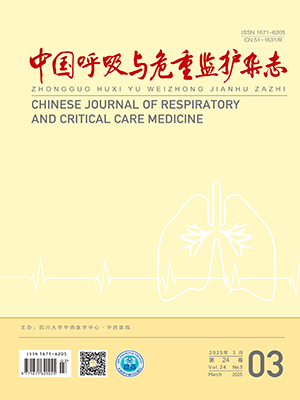To evaluate the clinical efficacy and safety of piperacillin/ tazobactam in the treatment of hospital acquired pneumonia( HAP) . Methods A multicenter, open-labeled, non-comparative clinical trial was conducted. Patients with HAP were administered intravenously with piperacillin /tazobactam( 4. 5 g) every 8 h for 7-14 days. Results A total of 250 patients were enrolled in this study and 246 subjects were clinical valuable. At the end point, the clinical efficacy rate was 81. 7% ( 201 /246) and the bacterial eradication rate was 74. 1% ( 83 /112) . The rate of drug related adverse events was 2. 8% ( 7 /250) , in which 4 cases had clinical significance ( rash, dyspnea, injection site pain and diarrhea, respectively) and 3 cases had abnormal laboratory findings ( hepatic dysfuction , eosinophilia and so on ) . All events were mild and transient . Conclusions Piperacillin/ tazobactamis effective and safe in the treatment of HAP, therefore, it is recommended as one of the first-line antibiotics to treat the patients with HAP.
Citation:
Treatment of Hospital Acquired Pneumonia Forum in Huadong Area. ZHOU Xin,WAN Huanying,ZHU Huili,SHI Yi,LIN Zhangshu,JIANG Handong,ZHOU Jianying,LIU Rongyu.. A Multicenter Clinical Trial on the Efficacy and Safety of Piperacillin/tazobactam for the Treatment of Patients with Hospital Acquired Pneumonia. Chinese Journal of Respiratory and Critical Care Medicine, 2009, 09(1): 20-23. doi:
Copy
Copyright © the editorial department of Chinese Journal of Respiratory and Critical Care Medicine of West China Medical Publisher. All rights reserved
| 1. |
Cunba BA. Nosocomial pneumonia. Diagnostic and therapeutic considerations. Med Clin North Am, 2001, 85: 79-114.
|
| 2. |
Depuydt P, Myny D, Blot S. Nosocomial pneumonia: aetiology,diagnosis and treatment. Curr Opin Pulm Med, 2006, 12: 192-197.
|
| 3. |
Cunha BA. Antibiotic selection is crucical of optimal empiric monotherapy of ventilator-associated pneumonia. Crit Care Med, 2007, 35:1992-1994.
|
| 4. |
Rello J. Importance of appropriate initial antibiotic therapy and de-escalation in the treatment of nosocomial pneumonia. Eur Respir Rev, 2007, 16: 33-39.
|
| 5. |
黎毅敏, 黄红川, 刘晓青, 等. 重症监护病房铜绿假单胞菌医院获得性感染暴发的流行病学调查. 中国呼吸与危重监护杂志,2006, 5: 413-417.
|
| 6. |
Schmitt DV, Leitner E, Welte T, et al. Piperacillin /Tazobactam vs Imipnenem/ cilaslatin in the treatment of nosocomial pneumonia-a double blind prospective multicentre study. Infection, 2006, 34 :127 -134.
|
| 7. |
Yong M, Plosker GL. Piperacillin/ tazobactam: a pharmacoeconomic review of its use in moderate to severe bactierial infections. Pharmacoeconomics, 2001, 19: 1135-1175.
|
| 8. |
American Thoracic Society; Infections Diseases Society of America.Guidelines for the management of adults with hospital-acquired, ventilator-associated and healthcare-associated pneumonia. Am J RespirCrit Care Med, 2005, 171: 388-416.
|
- 1. Cunba BA. Nosocomial pneumonia. Diagnostic and therapeutic considerations. Med Clin North Am, 2001, 85: 79-114.
- 2. Depuydt P, Myny D, Blot S. Nosocomial pneumonia: aetiology,diagnosis and treatment. Curr Opin Pulm Med, 2006, 12: 192-197.
- 3. Cunha BA. Antibiotic selection is crucical of optimal empiric monotherapy of ventilator-associated pneumonia. Crit Care Med, 2007, 35:1992-1994.
- 4. Rello J. Importance of appropriate initial antibiotic therapy and de-escalation in the treatment of nosocomial pneumonia. Eur Respir Rev, 2007, 16: 33-39.
- 5. 黎毅敏, 黄红川, 刘晓青, 等. 重症监护病房铜绿假单胞菌医院获得性感染暴发的流行病学调查. 中国呼吸与危重监护杂志,2006, 5: 413-417.
- 6. Schmitt DV, Leitner E, Welte T, et al. Piperacillin /Tazobactam vs Imipnenem/ cilaslatin in the treatment of nosocomial pneumonia-a double blind prospective multicentre study. Infection, 2006, 34 :127 -134.
- 7. Yong M, Plosker GL. Piperacillin/ tazobactam: a pharmacoeconomic review of its use in moderate to severe bactierial infections. Pharmacoeconomics, 2001, 19: 1135-1175.
- 8. American Thoracic Society; Infections Diseases Society of America.Guidelines for the management of adults with hospital-acquired, ventilator-associated and healthcare-associated pneumonia. Am J RespirCrit Care Med, 2005, 171: 388-416.




